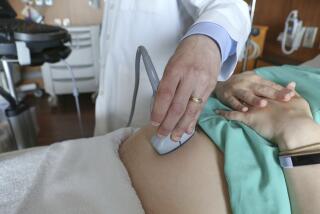Study Criticizes Routine Use of Episiotomy : Medicine: Women recovered quicker and with less pain after giving birth when not subjected to common procedure.
- Share via
Episiotomies, the common surgery to enlarge a woman’s vagina to ease delivery of a baby, should not be a routine part of the birth process, a recent study concludes.
Canadian researchers at the Jewish General Hospital and McGill University, both in Montreal, in a study of more than 700 births, found that women who did not have the procedure recovered quicker and experienced less pain after delivery.
An episiotomy is performed in 70% to 80% of births in North America, making it one of the most common techniques used in Western medicine, according to the study, which was published in the American Assn. for the Advancement of Science’s new computer-based Online Journal of Current Clinical Trials.
In an episiotomy, an incision is made in the perineum, the tissue between the vagina and anus, to enlarge the birth canal so that labor can move more quickly. Doctors can insert instruments to help deliver the baby and ragged skin or muscle tears are less likely to develop.
Severe tearing of the perineum, which can happen when the baby’s head emerges, can be more painful, harder to heal and create more complications than the episiotomy and, later in life, such tears may weaken pelvic muscles and cause incontinence and other complications, argue doctors who advocate episiotomies.
In the study, women from three hospitals in Montreal were randomly selected and divided into two groups. Physicians in one group were instructed to try to avoid tissue tears by doing an episiotomy. Doctors in the second group were told to restrict use of the procedure unless there was a clear medical need.
“Based on the results of our study, it is our recommendation that liberal or routine use of episiotomy be abandoned,” the authors wrote.
The researchers found that episiotomies should be used only when there is evidence of fetal distress or because instruments are needed to assist with delivery.
“Forty-six out of 47 women who had an episiotomy had the tear extend into the rectum, producing the worst outcome,” said Michael C. Klein, a professor of family medicine at McGill University and one of the study authors. “It makes sense that if you take a scissors, cut a piece of paper and pull on it, the cut will extend.”
Klein also noted that the physicians who restricted their use of episiotomies had a lower severe-tear rate--one that reached the rectum--of 4.9% compared to 23% for doctors who continued to perform the procedure. “In fact,” he said, “it is the procedure itself that leads to the severe tear.”
The American College of Obstetricians and Gynecologists, in its published guidelines on perinatal care, says episiotomies should not be considered routine. “The presence of a short perineum, a large baby and the need to shorten the second stage of labor are some of the current indications for use,” according to the guidelines.
Not all experts agree with the notion that physicians routinely perform episiotomies during most births. “The vast majority of times, it is used if there is any concern about the heart rate of the baby, if the mother just can’t push anymore or if there are a multitude of tears in the vaginal tissue,” said Connie Bohon, an obstetrician-gynecologist in the District of Columbia and Maryland.
Some physicians argue that although an episiotomy can be painful initially, it can provide long-term benefits. If the perineum is not properly protected during birth, a woman may require surgical repair later in life, said Brooks Ranney, a professor of obstetrics and gynecology at the University of South Dakota School of Medicine.
“It is a nuisance to have the aches and pains of any incision and that is a very sensitive part of the body,” he said. “But without an episiotomy, there may be weaknesses in the perineum that can cause a woman trouble 30 or 40 years later.”
Klein disagreed, saying the effects of episiotomies on women later in life have never been studied. To prevent tears, it is possible that perineal massage before or during delivery may be beneficial or the woman’s position during birth might make a difference, but this area of medicine has also not been studied, he said.
“What has kept these things from being studied is the medical Establishment’s belief that this is something trivial and not worth studying,” he said. “Well, women don’t think it is a trivial issue. It depends on whether you believe women are unreliable incubators or whether they are competent, mature adults.”





